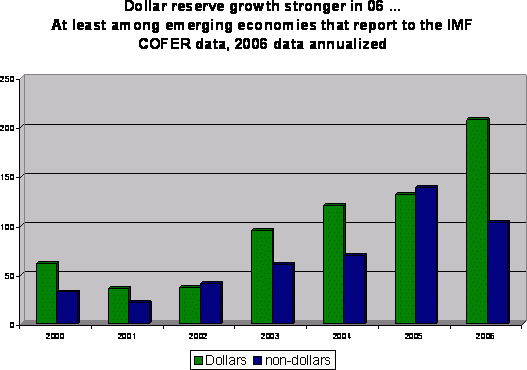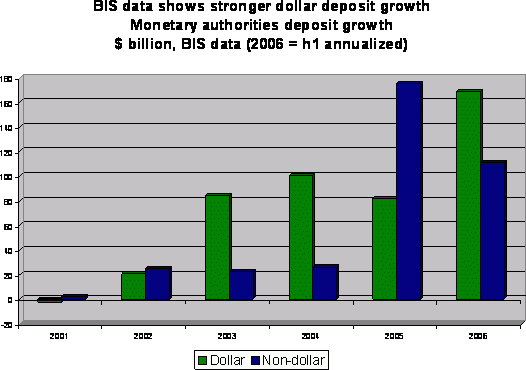Dollar and euros — not dollars or euros. And more dollars than euros in 2006
More on:
I have every incentive in the world to find evidence that central banks have diversified away from the dollar. I like being right as much as the next guy. Back in early 2005, Nouriel and I -- building on an idea put forward by Barry Eichengreen -- argued that the world’s central banks would compete to shift away from the dollar, leading the Bretton Woods system to unravel sooner than most thought.
But I haven’t been able to find the evidence. Not good evidence. At least not in the global data.
Some individual countries clearly have moved away from the dollar. Russia for one. It is big enough to matter. Russian diversification may have been an underlying source of pressure on the dollar in q2. Russia clearly bought a lot more euros and pounds than dollars in 2006 to bring the dollar’s share of its rapidly growing reserves down from say a bit under 70% to 50% even as its reserves went from $182b to about $300b.
Other central banks, though, seem to have stepped their dollar purchases. The aggregate data has lots of gaps, but it still suggests that central banks bought a lot more dollars in 2006 than in 2005. At least in the first three quarters of the year (the charts are below). And what evidence is available suggests that central banks bought even more dollars in the fourth quarter.
I consequently think stories (and blogs) asking whether the euro has supplanted the dollar as a reserve currency often miss the key point. The real story isn’t that central banks are shifting out of dollars into euros -- or even that the euro may not be ready to serve as a reserve currency.
In my view, the euro is already a major reserve currency: annual growth in euro reserve growth in 2005 and 2006 likely topped global reserve growth in 2000 and 2001. Central bank inflows increasingly shape the European economy in much the same way they shape the US economy: they help keep eurozone rates down and eurozone asset prices up. Houses aren’t exactly cheap in many European countries. Cheap financing has fueled a European private equity boom. And so on.
No, the real story is that emerging market central banks are adding to both their dollar and euro portfolios at an unprecedented rate. Emerging economies are increasingly resisting appreciation against both the dollar and the euro – and in the process financing both a large US deficit and a small European deficit.
In 2005, they bought an an unusally large amout of euros and pounds -- though total dollar purchases still exceeded euro and pound purchases. In 2006, emerging market central banks look set to add a very large sum of dollars to their porfolios.
Why? Setting the Bank of Russia and a few small players aside, central banks seem to have acted as a stabilizing force in the fx market, buying dollars when others don’t want to. Private market participants were less inclined to finance the US in 2006 than in 2005, leading (or forcing?) central banks to do more.
I suspect emerging markets added – if you annualize the data -- $800b to their reserves (including all Saudi central bank foreign assets) in the second half of 2006. Q3 reserve growth was strong, and Q4 looks to be even stronger. $800b is a slight acceleration from the roughly $700b pace of reserve growth in the first half of the year. (RGE Premium Subscribers who want the gory details can find them in this rather technical presentation)
Emerging economies probably added another $100b, maybe a bit less to their oil investment funds over the same period (for much more on oil funds, see Higgins, Klitgaard and Lerman’s recent paper – they have a higher number for oil funds, but a lower number for oil reserves than I do, largely I suspect because of differences in how they are handling the Saudi’s non-reserve foreign assets).
If 60% of the all central bank reserve growth went into dollars and 40% went into euros and other currencies, central banks added to the dollar portfolios at a $500b annual pace in the second half of 2006 – a level of reserve growth that matches 2004. Add in oil funds and total official flows into dollars might be closer to $560b.
That leaves $300-340b of inflows into non-dollar assets – not a small sum. The story is more of everything, not more euros and fewer dollars.
However, I also think a 60% dollar share of new reserves is quite conservative. A 70% dollar share would imply central banks and oil funds added to their stock of dollars at a $550-600b annual pace in the second half of 2006.
That is a huge sum. I wouldn’t believe it is I didn’t see evidence of rapid reserve growth on the balance sheets of various central banks … and in the available global data.
The best data come from the IMF (the COFER data) and the BIS, but oth data sources have gaps. Lots of countries don’t report data on the currency composition of their reserves to the IMF. The BIS data only captures deposits in the international banking system – and not even all of those. It only captures deposits from monetary authorities in banks in jurisdictions that report to the BIS. Securities aren’t counted as all.
China, incidentally, doesn’t appear in either data set. It doesn’t report data on the currency composition of its reserves to the IMF. And the SAFE isn’t a monetary authority so it isn’t counted in the BIS data.
That said, both data sets tell a consistent story – emerging market central bank demand for dollars went up in 2006. Absolutely. And relative to central bank demand for non-dollar reserve assets.
We now have COFER data on the currency composition of the reserves of those emerging economies that report this data the IMF for the first three quarters of the year. I adjusted for valuation effects – and annualized the data.

The emerging economies that report have around 60% of their reserves in dollars. My personal view is that the emerging economies that do not report have a higher dollar share. We don’t know precisely who doesn’t report data to the IMF. China clearly doesn’t. And the set of countries that doesn't report likely includes places like Taiwan (not a member of the IMF) and a host of generally non-transparent oil exporting countries as well. They generally peg to the dollar and seem to have high dollar reserve shares, best I can tell.
Indeed, these countries are the reason why I think in aggregate central banks bought more dollars than pounds and euros in 2005. If they acted like the emerging economies that do report, they also stepped up their dollar purchases in 2006.
Second, the BIS data. It just covers the first half of the year – a period of strong deposit growth. The BIS staff reports data that is already adjusted for valuation, so I just annualized the data.

You can argue that central banks ability to shift – relatively speaking – toward the euro in 2005 shows that central banks don’t have an impact on the market. I think that misreads the data. Central banks can sell when there is strong private demand for dollars. In 2005, interest rate differentials favored the dollar – and the US homeland investment act reduced the United States need for external financing. That context made it possible for central banks to shift away from the dollar. Though it is important to reiterate that central banks continued to add substantially to their overall dollar portfolio in 2005; they just increased their holdings of other currencies at a much faster pace than before.
If central banks really sold when private demand for dollars was weak, adding to private market pressure rather than offsetting it, the dollar could really fall sharply.
The current global equilibrium hinges on central banks willingness stepping up their intervention and buy more dollars during periods of dollar weakness.
I suspect that lots of central banks are going into 2007 with more dollars than they really want, and are looking for an opportunity to shift into euros. As happened in 2005. But there is some risk that such an opportunity won’t come. If the dollar slides some more, central banks may have to buy even more dollars in 2007 than they did in 2006. At least if they want to continue to peg to the dollar.
And right now more countries seem to be firming up their dollar pegs than getting out of them. But we also have plenty of evidence -- see Thailand and Korea -- that accumulating reserves long after you have more reserves than you need can be costly. The balance different countries strike between their government's desire to keep their currencies from appreciating and their central banks' desire to slow the pace of reserve growth will be central to the ongoing evolution of the global economy.
Update: the idea that central banks went into 2007 holding more dollars than they wanted is consistent with today's Bloomberg story of central banks selling into the dollar's recent mini-rally.
More on:
 Online Store
Online Store
